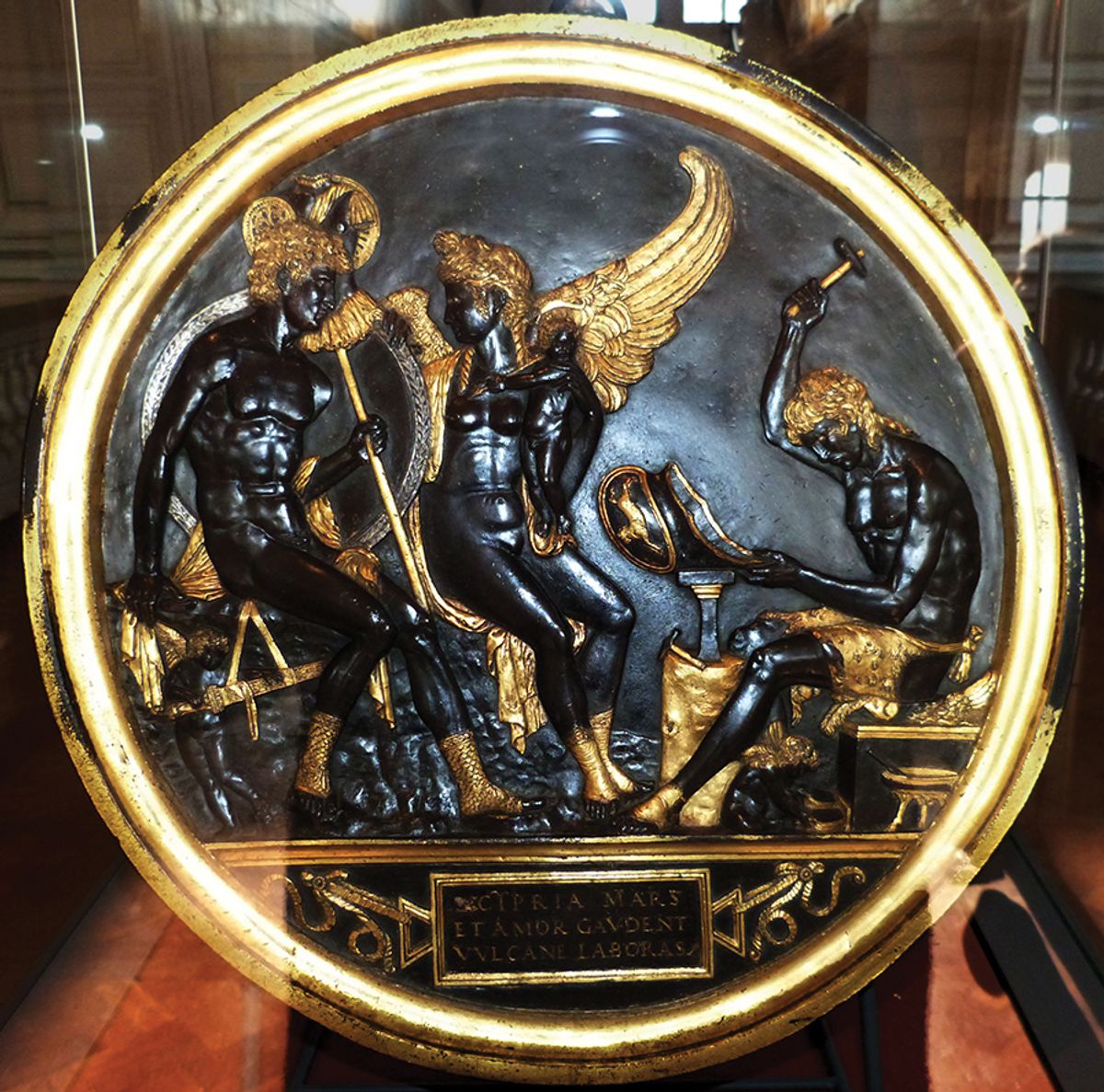Two masterpieces, subject to export licence deferrals by the UK government, are now likely to go abroad. UK museums can hardly try to buy multi-million-pound works of art when they are making large numbers of staff redundant as a result of Covid-19. It is unclear whether private owners wanting to send works abroad see this as an opportune moment to apply for export licences—or if this is mere coincidence.
Items currently deferred, to allow UK buyers the chance to match the price, include a stunning £20.4m Italian roundel and a £10m German reliquary. In the past, London’s Victoria and Albert Museum (V&A) and Edinburgh’s National Museums Scotland have each tried to acquire one of these objects—but were thwarted. Both items have a controversial recent past.
Mantuan roundel
The Mantuan roundel was a major discovery when it emerged in 2003 in a Christie’s sale. Dating from around 1480-1500, the large (42cm diameter) bronze depicts four Roman gods, along with a Latin inscription: “While Venus, Mars and Cupid enjoy themselves, Vulcan labours.” The roundel was sold by the Treby family from Devon, who had probably acquired it in 1746. At auction, it fetched £7m.
The Art Newspaper revealed that the 2003 buyer was Sheikh Saud al-Thani, a member of the Qatar royal family and minister of culture. The following year the UK Export Reviewing Committee gave the roundel a starred rating, meaning that every possible effort should be made to save it for the nation.
There has inevitably been some shift in priorities as museums navigate the pandemicSpokeswoman, Art Fund
The V&A expressed a serious intention to raise £7m, but once this became known to Al-Thani he withdrew his export licence application—a move that went against the spirit of the export licence system. Al-Thani was obliged to keep the roundel in the UK. He presumably had little use for it in these circumstances and lent it to the V&A from 2010 to 2012 (and later that year it was in the Bronze exhibition at the Royal Academy of Arts).
It had been unclear whether the prince or the Qatari state was the ultimate owner of the roundel, since in the Gulf such distinctions are sometimes blurred. In 2005, Al-Thani was dismissed and placed briefly under house arrest while some of his purchases were investigated. He died in 2014 and the recent Export Reviewing Committee’s comment that the roundel passed “by descent” suggests that it was the Al-Thani family’s personal property, not that of the Qatari state. In 2019, it was sold to an unidentified buyer.
An export licence deferral on the roundel, now valued at £17m (£20.4m with VAT), was announced by the UK’s culture department on 28 May. This period will run until 27 September (or 27 March 2022 if there is a serious intention to raise the funds).
However, a V&A spokesperson tells The Art Newspaper that “we currently have no plans to acquire” the roundel. “Alongside reviewing operational budgets, we have taken every step to reduce costs and mitigate the impact of Covid-19 since the start of the pandemic, including significantly reducing overall acquisition budgets.” Spending this sum of money would indeed be extremely difficult when the museum is facing a massive financial deficit due to the pandemic. The museum lost £35m in self-generated income in 2020-21 and is making 15% of its staff redundant.

Canada bound? National Museums Scotland previously launched an unsuccessful bid to buy this reliquary DCMS
St Christopher reliquary
The precious German reliquary figure of St Christopher (1493) suffered a similar fate. The gilt statue on a reliquary base had come from the Wernher collection at Luton Hoo and was sold at Christie’s in 2000, going for £1.8m.
National Museums Scotland then began a serious effort to match the price after an export licence was deferred (and the reliquary, too, was given a starred rating). But when the purchaser learned about the museum’s intention they withdrew their application.
The buyer turned out to be the Canadian collector Ken Thomson, who died in 2006, and the reliquary then presumably passed to his heirs. For a period it received a temporary UK export licence to go on display at the Art Gallery of Ontario in Toronto.
In May, it was announced that a new export licence application had been made and the deferral period will run until 3 October (and could be extended until 3 April 2022). But National Museums Scotland tells The Art Newspaper that it will not be trying to acquire the reliquary.
Despite the problems of Covid-19, a few items have recently been saved, including the £600,000 Spanish Armada map (1588) bought by Portsmouth’s National Museum of the Royal Navy, which was announced in January. A month later, it was reported that a £150,000 Roman mosaic (around AD400) had been acquired by Dorset County Museum.
But as an Art Fund spokeswoman says: “There has inevitably been some shift in priorities as museums navigate the pandemic.” Multi-million-pound objects that are export-deferred are likely to get away for the next year or two, as museums gradually recover from the financial impact of Covid-19.


